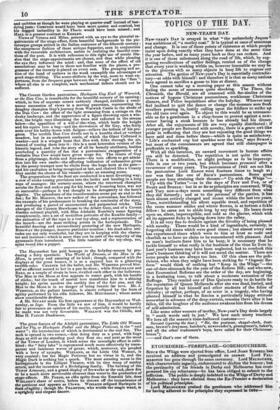The Covent Garden pantomime, Harlequin Guy Earl of Warwick, or
the Dun Cow, is remarkable for the beautiful scenery of its opening ; which, in lien of separate scenes suddenly changed, exhibits a conti- nuous succession of views in a moving panorama, representing the doughty champion Guy's journey from Warwick Castle to the abode of the Dun Cow : the effect of the light streaming from a cottage on the dusky landscape, and the appearance of a figure throwing open a win- dow, the bright rays illumining the trees and reflected in the stream below—the apparition of a will-o'-the-wisp, which leads the knight and his squire into a bog—and the drowsiness of Sir Guy, who fairly nods over his hobby-horse with fatigue—relieve the tedium of his pro- gress. The terrible Dun Cow dwells not in a humble shed or verdant meadow, but in an enchanted castle, of which the Giant Colbrand is warder—and is a winged beast that flies with folks through the air, instead of tossing them into it : this is a most heterodox version of the historic legend, and robs the story of all its homely attributes, besides precluding a quantity of fun that a pantomimic exaggeration of a veritable Dun Cow would have given scope for. The return of Guy from a pilgrimage, feeble and foot-sore—his vain efforts to get admis- sion into his own castle—the affecting indication of exhaustion given by the penny-trumpet note he elicits from the huge horn at the gate— and his exaltation at being recognized at last, and chaired like a County Guy amidst the cheers of his vassals—make an amusing scene. The preparations for the feast are conducted in a most diverting way; a row of cooks tossing provisions into the larder and hauling in a long rope of sausages: the nursery-scene, where the renowned champion scrubs the floor and makes pap for his brace of bouncing boys, was not so successful—perhaps it was thought to be derogatory to the hero's dignity. The splendours of the transformation-scene put an end to the fun ; for Mr. MORTON, the new author of the pantomime, has followed the example of his predecessors in breaking the continuity of the story, and producing a parcel of unconnected and purposeless tricks. The changes of the Cannon Brewhouse to the Albert Gate, and of a Covent Garden colossal playbill, with Miss Adelaide Kemble's name figuring conspicuously, into a set of medallion portraits of the Semble family— the animation of all the toys in a vast toy-shop, and a representation of the launch—are the most striking points in the harlequinade. The beautiful dancing and extraordinary posturing of the new Harlequin, RIDGWAY the younger, deserve particular mention : his dead-alive atti- tudes are not only wonderful, but they are in keeping with the charac- ter and incident—which is more than can be said of the majority of thq gymnastic feats introduced. The little tumbler of the toy-shop, too, spins round„Itke a puppet.































 Previous page
Previous page